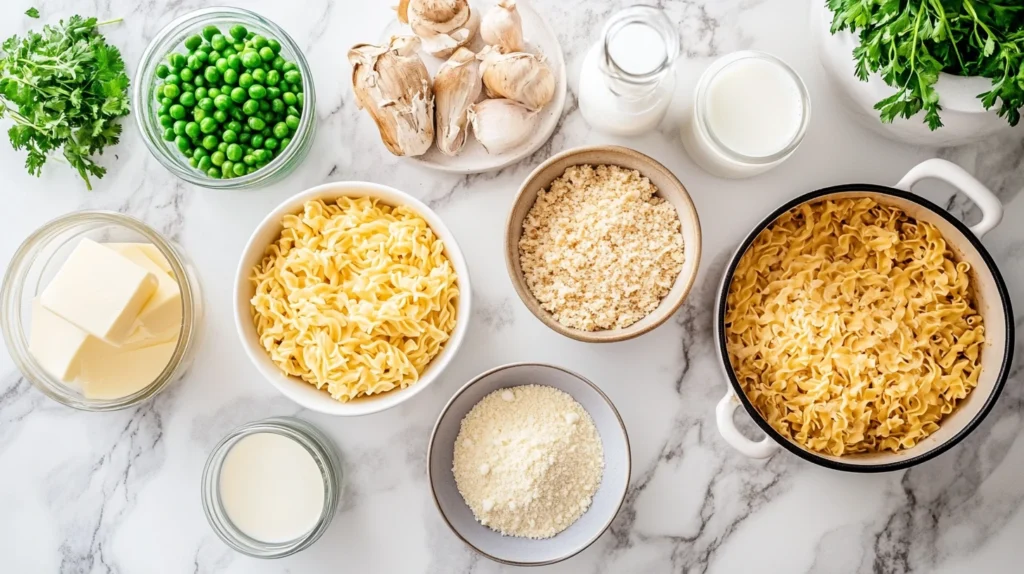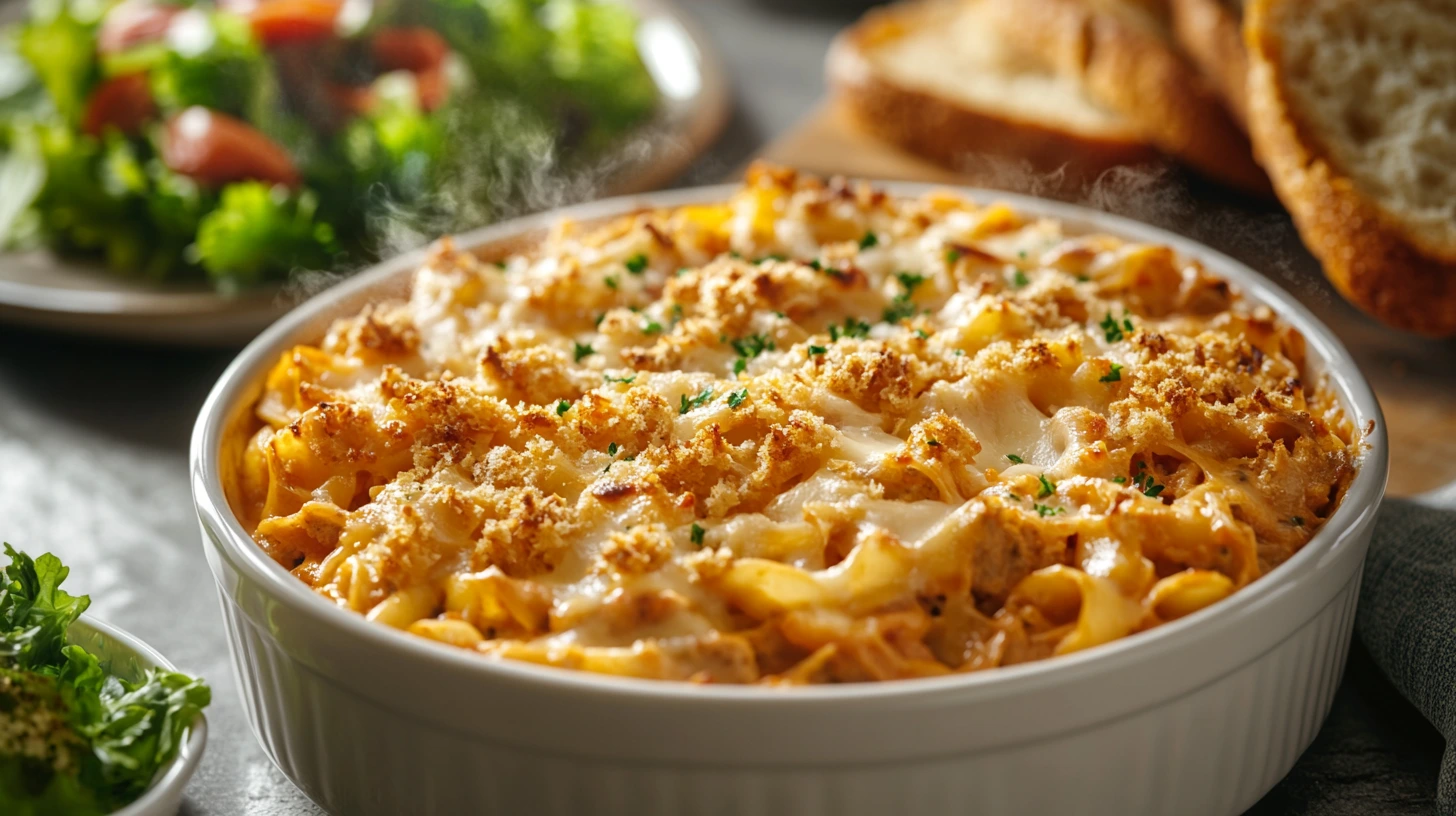What Makes This Classic Tuna Noodle Casserole So Special?
Few dishes evoke nostalgia quite like a classic tuna noodle casserole. Originating in mid-20th-century kitchens, this hearty and affordable dish became a staple for families seeking comforting, budget-friendly meals. Packed with tender noodles, creamy sauce, and the savory goodness of tuna, it’s no wonder this casserole has endured as a household favorite for generations.
Moreover, its versatility allows home cooks to get creative with ingredients while still preserving its beloved flavor. In addition, the simplicity of the recipe makes it perfect for weeknight dinners or potluck gatherings. Furthermore, casseroles like this one reflect the tradition of communal meals that bring people together.
Want to learn more about the fascinating history of casseroles? Check out this detailed guide on casserole origins.
Ingredients for the Best Tuna Noodle Casserole
Ingredients:
- 12 oz egg noodles (or substitute with gluten-free pasta).
- 2 cans (10 oz each) of tuna, drained (use chunk light or solid white).
- 1 can (10.5 oz) cream of mushroom soup (alternatives: cream of celery or a homemade white sauce).
- 1 cup milk (any dairy or non-dairy alternative works).
- 1½ cups shredded cheddar cheese (or use a blend of your favorite cheeses).
- ½ cup frozen peas (optional, or substitute with diced carrots or celery).
- 1 cup breadcrumbs (or crushed crackers for a crunchier topping).
- 2 tbsp butter, melted (to mix with breadcrumbs for the topping).
- Salt and pepper, to taste.
Equipment:
- 9×13-inch casserole dish
- Large pot for boiling noodles
- Mixing bowl
- Measuring cups and spoons
- Spatula or wooden spoon
- Aluminum foil (for covering during baking)
For more guidance on selecting quality canned tuna, read this detailed guide.

Step-by-Step Instructions for Making an Easy Tuna Casserole
Step 1: Prepare Your Ingredients
First, preheat your oven to 375°F (190°C) and grease your 9×13-inch casserole dish with non-stick spray or butter. Gather all your ingredients, ensuring the tuna is drained and the frozen peas are thawed if using.
Step 2: Cook the Noodles
Next, bring a large pot of salted water to a boil. Add the egg noodles and cook them al dente according to the package instructions—usually 6-8 minutes. Drain the noodles and set them aside.
Pro Tip: Slightly undercook the noodles, as they will continue to soften while baking.
For tips on perfect pasta cooking, check out our guide to pasta techniques.
Step 3: Make the Sauce
Meanwhile, in a mixing bowl, combine the cream of mushroom soup, milk, salt, and pepper. Whisk until smooth. If you prefer a richer sauce, add a splash of heavy cream or a dollop of sour cream.
Pro Tip: Want a healthier option? Swap the cream soup for a homemade white sauce made with butter, flour, and broth.
Step 4: Assemble the Casserole
In the casserole dish, layer the cooked noodles, drained tuna, and optional vegetables. Pour the sauce mixture evenly over the top, ensuring everything is well coated. Gently stir to combine the layers.
Step 5: Add the Topping
In a small bowl, mix breadcrumbs with melted butter. Sprinkle this mixture evenly over the casserole, followed by the shredded cheese.
Step 6: Bake to Perfection
Cover the casserole with aluminum foil to prevent the topping from over-browning. Bake in the preheated oven for 20 minutes. Then, remove the foil and bake for an additional 10 minutes or until the top is golden and bubbling.
Step 7: Let It Rest and Serve
Finally, remove the casserole from the oven and allow it to rest for 5 minutes before serving. This step helps the layers set and enhances the overall flavor.
Enjoy your homemade tuna noodle casserole—an enduring classic that never goes out of style!

Tips for Perfecting a Classic Tuna Noodle Casserole
Achieving the ideal tuna noodle casserole takes attention to detail. Here are a few tips and tricks to ensure success every time:
- Avoiding Soggy Noodles:
Undercook your noodles slightly, boiling them 1-2 minutes less than the package instructions. They will absorb the sauce while baking and finish cooking in the oven. However, avoid skipping this step, as fully cooked noodles may become too soft. - Achieving the Perfect Creaminess:
To ensure a rich, creamy texture, use full-fat dairy options like whole milk or add a splash of heavy cream to the sauce. On the other hand, if you’re looking for a lighter version, opt for non-dairy alternatives like almond or oat milk, but consider adding a tablespoon of cornstarch for thickness. - Getting a Golden Crust:
For a crispy and golden topping, mix breadcrumbs with melted butter before sprinkling them on top. Bake uncovered for the final 10 minutes to achieve the perfect crust. Additionally, broil the casserole for 1-2 minutes at the end if you prefer an extra-crispy finish.
Pairing and Serving Ideas for Your Creamy Tuna Noodle Casserole
A well-presented tuna noodle casserole elevates the dining experience. Consider these serving and garnishing suggestions:
- Complementary Side Dishes:
Pair the casserole with a refreshing green salad topped with vinaigrette to balance the dish’s richness. Likewise, warm garlic bread or a buttery dinner roll makes an excellent side. - Garnishing Tips:
Sprinkle freshly chopped parsley or dill over the casserole just before serving for a burst of color and added flavor. To summarize, a simple garnish can transform your casserole from basic to gourmet.
Common Questions About Tuna Noodle Casserole and Solutions
Even experienced cooks can encounter challenges when preparing a tuna noodle casserole. Here’s how to address common mistakes:
- Overcooked Noodles:
Solution: Slightly undercook the noodles before baking to prevent them from becoming mushy. Cool them quickly after draining to stop the cooking process. - Dry Casserole:
Solution: If your casserole turns out dry, ensure the sauce fully coats the noodles and add an extra ¼ cup of milk or broth before baking. Covering the dish with foil during the first 20 minutes of baking helps retain moisture. - Lack of Flavor:
Solution: Enhance the seasoning with garlic powder, onion powder, or a dash of Worcestershire sauce. A sprinkle of Parmesan cheese can also boost umami.
By following these solutions, you can avoid common pitfalls and create a consistently delicious casserole.
FAQs About The Best Old-Fashioned Tuna Noodle Casserole
1. Can I make it ahead of time?
Absolutely! Preparing this casserole ahead of time is easy and convenient. For example, you can assemble the casserole up to 24 hours in advance, cover it tightly, and refrigerate it until ready to bake. Thus, it’s perfect for busy weeknights or hosting a dinner party. When baking, add an extra 10 minutes to the cooking time if it’s coming straight from the fridge.
2. What are the best noodles to use?
Egg noodles are a classic choice for tuna noodle casserole because of their tender texture and ability to soak up the creamy sauce. However, other options like rotini or penne work well too. Consequently, using a sturdier pasta shape can help the casserole hold up better during baking and serving.
3. How do I reheat leftovers for the best taste?
To reheat, cover the casserole with foil and warm it in the oven at 350°F (175°C) for about 20 minutes. For smaller portions, a microwave works well, but add a splash of milk or broth to keep it moist. Reheating this way ensures the flavors remain delicious and the texture stays creamy.
FAQs
4. Why is my tuna casserole so dry?
Dry casseroles often result from not using enough sauce or overcooking. For example, ensure the sauce fully coats the noodles before baking, and cover the dish with foil for the first part of the baking process to retain moisture.
5. Is it better to put tuna in water or oil for a casserole?
Tuna packed in water is a lighter option and blends seamlessly into the casserole without overpowering flavors. On the other hand, tuna in oil adds richness and depth but can make the dish slightly heavier. Choose based on your preference and dietary needs.
6. How many days is tuna noodle casserole good for?
Tuna noodle casserole is best enjoyed within 3-4 days if stored properly in an airtight container in the refrigerator. Thus, it’s a great make-ahead option for meal planning!
Conclusion
In conclusion, “The Best Old-Fashioned Tuna Noodle Casserole” is more than just a meal—it’s a nostalgic trip back to the comforting flavors of home-cooked dinners. This recipe embodies everything that makes comfort food so cherished: simplicity, heartiness, and a flavor that brings families together around the table. Moreover, whether you’re preparing it for a cozy weeknight dinner or a special potluck gathering, this casserole is sure to be a hit.
All things considered, the beauty of this dish lies in its versatility. For instance, you can stick to the classic recipe or put your own unique spin on it. Add your favorite vegetables like peas or carrots for a pop of color and nutrients, or experiment with different toppings like crispy onions or crushed crackers to create a new texture. In addition, the possibilities are endless, making it a perfect choice for home cooks of all levels.
Finally, don’t let any leftover casserole go to waste! In fact, tuna noodle casserole is just as delicious the next day, and with proper reheating techniques, it tastes as good as fresh. Furthermore, it’s also an excellent make-ahead dish, saving you time while ensuring a delicious meal is always ready to serve.
If you enjoyed this recipe, why not explore other comforting dishes to add to your repertoire? For example, check out our Chicken Noodle Casserole for another family favorite, or browse through our collection of hearty pasta recipes for more inspiration.
We’d love to hear how your casserole turned out! Did you stick to the traditional recipe, or did you add your own creative twist? Additionally, share your experience in the comments below and tag us in your photos on social media. Let’s keep the tradition of this classic dish alive, one casserole at a time. Happy cooking, and bon appétit!




